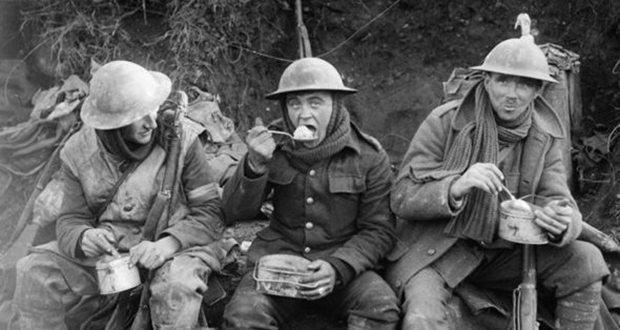1Corned Beef Grenades

During World War 1, Canadians exploited the trust of Germans who had become accustomed to fraternizing with allied units. They threw tins of corned beef into a neighboring German trench and when the Germans shouted “More! Give us more!” the Canadians tossed a bunch of grenades over.
2. During World War 1, up to 12 million letters were delivered every week to soldiers by the British General Post Office.
3. During World War 1, the British army tried to train seagulls to defecate onto submarine periscopes.
4. In 1915 during World War 1, when Belgian and German trenches were a mere 45 meters (150 feet) apart, there was “Battle of the Words.” Each side threw insults at each other all day and night. It eventually became so annoying that the Belgian commander forbade his men from talking to the Germans.
5. Many World War 1 soldiers invading enemy trenches preferred to use a sharpened spade as an improvised melee weapon instead of the bayonet, as the bayonet tended to get "stuck" in stabbed opponents, rendering it useless in heated battle.
Latest FactRepublic Video:
15 Most Controversial & Costly Blunders in History
6RAF Plane

During World War 1, when Britain had to deal with the scourge of Zeppelins bombing them, the Royal Air Force initially sent up a plane equipped with a passenger and a rifle, with just 4 incendiary rounds.
7. The Australians invented a boomerang grenade during World War 1.
8. During World War 1, citizens of many countries and even their newspapers celebrated the beginning of the war, claiming to be “bored with peace.”
9. During World War 1, the American government passed the Chamberlain Kahn Act which allowed the police to detain any woman suspected of having a venereal disease and force her to be checked. Tens of thousands of women were detained while the law was enacted, but venereal disease rates remained the same.
10. During World War 1, Russia recruited 60,000 Czech and Slovak troops (The Czechoslovak Legions) to fight the Hapsburgs. After the Bolshevik Revolution, they took on all comers, plundered the Tsar's gold, and battled their way across Eurasia to the Pacific. They then sailed back to their homelands.
11Cats in War

During World War 1, approximately 500,000 cats were sent to the trenches and warships to control pests and detect mustard gas.
12. During World War 1, the Daily Mail asked British housewives to make basic gas masks to be sent to the frontlines. However the design of these masks was flawed and scores of soldiers suffocated to death.
13. Mustard gas, which was used heavily during World War 1, is not just a skin irritant but damages DNA by corrupting molecules in the strand. If the victim survives, the DNA damage can lead to the development of cancer.
14. The trenches on the western front of World War 1 from the North Sea all the way down to Switzerland were dug in only just over a month in the race to the sea when the allies and the axis powers kept trying to outflank each other.
15. To raise war bonds during World War 1, the United States transported a captured U-Boat (donated by the British) to Central Park in New York City. It was renamed “U-Buy-A-Bond.”
16Wearing Pyjamas

During World War 1, people in England started wearing pajamas, originally spelled “pyjamas,” instead of nightgowns so that they would always be prepared to run outside in public in case of an air raid.
17. Planes in World War 1 used a “Synchronization Gear” to prevent the bullets fired from the machine gun mounted behind the propeller from hitting it.
18. During World War 1, a team of miners secretly dug tunnels under the German trenches to plant and detonate mines. These detonations in France were sometimes so loud that they were often heard in London, 140 miles away.
19. During World War 1, the British and German governments agreed to trade British rubber for German binoculars so that both sides could kill each other more effectively.
20. During the Siege of Przemysl in World War 1, daily announcements were issued in 15 different languages due to the ethnic diversity of the Austro-Hungarian inhabitants.
21WW1 Fragment Deaths

World War 1 was a fragmented war. The range of casualties due artillery and mortar fragments was as high as 70% to 95%. Steel fragments do not come at soldiers like a rifle or machine-gun bullets. Nearly all of them move at less than 1,000 feet per second.
22. There were two pandemics running together during World War 1. One was the Spanish Flu and the other one was Encephalitis Lethargica. It affected 5 million and killed over 1.5 million of them. Patients suffering from it were conscious yet not fully awake. They would sit motionless, totally lacking initiative, affect, or desire. They registered the inputs with profound indifference.
23. During the Battle of Lake Tanganyika in World War 1, the Royal Navy essentially dragged a flotilla overland to check German dominance of a strategically important African lake.
24. Before the battle of Passchendaele during World War 1, 3,000 guns bombarded German lines in 10 days with over 4.25 million shells fired.
25. During World War 1, German Army uniforms were made mainly of nettles due to shortages of cotton.




